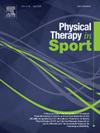男子橄榄球联盟运动员肩部功能轮廓从学院到专业水平的发展。
IF 2.2
3区 医学
Q1 REHABILITATION
引用次数: 0
摘要
目的:探讨优秀男子橄榄球联盟运动员肩关节功能随年龄、位置、优势和伤病史的变化。设计:观察。设置:运动设置。参与者:162名U16、U18、U21和职业球队球员。主要结果测量:参与者报告的结果测量,肱骨关节最大等距内外旋转强度,上肢y平衡测试稳定性,坐式单臂水平推力测试(SSAHPT),速度,力量和抗疲劳能力使用改良封闭动力链上肢稳定性测试。结果:强度(η2 = [0.24; 0.25]; p 2 = [0.36; 0.47]; p 2 = 0.10; p 2 = [0.02; 0.14]; p = [2 = 0.12; p 2 = 0.22; p 2 = [0.15; 0.18]; p结论:了解男子橄榄球联盟运动员肩关节功能的发展,有助于设计从学院到专业水平的预防损伤和提高运动成绩的方案。本文章由计算机程序翻译,如有差异,请以英文原文为准。
The progression of shoulder functional profile in male rugby union players from the academy to the professional level
Objective
To investigate the changes in shoulder functions with age, playing position, dominance and injury history in elite male rugby union players.
Design
Observational.
Setting
Sport setting.
Participants
162 players in U16, U18, U21 and professional squads.
Main outcome measures
Participant-reported outcome measures, maximal isometric internal and external rotation strength at glenohumeral joint, stability using Upper Quarter Y-Balance Test, power using Seated Single-Arm Horizontal Push Test (SSAHPT), and speed, power and resistance-to-fatigue using modified-Closed Kinetic Chain Upper Extremity Stability Test.
Results
The strength (η2 = [0.24; 0.25]; p < 0.001) and power (η2 = [0.36; 0.47]; p < 0.001) increased with increase in age, while stability and resistance-to-fatigue remained similar, and speed abilities decreased at professional level (η2 = 0.10; p < 0.001). The forwards' shoulders were stronger (η2 = [0.02; 0.14]; p = [<0.001; 0.02]) and more powerful (η2 = 0.12; p < 0.001) than those of backs, while backs’ shoulders presented higher speed abilities (η2 = 0.22; p < 0.001) and resistance-to-fatigue (η2 = 0.04; p = 0.02). No bilateral differences were found, except for SSAHPT, for which dominant side presented higher performance than nondominant one (η2 = 0.12; p < 0.001). The injury history only affected the perceived functions (η2 = [0.15; 0.18]; p < 0.001).
Conclusion
Understanding the progression of shoulder functions in male rugby union players is useful for designing injury prevention and performance enhancement programs from the academy to professional levels.
求助全文
通过发布文献求助,成功后即可免费获取论文全文。
去求助
来源期刊

Physical Therapy in Sport
医学-康复医学
CiteScore
4.50
自引率
8.30%
发文量
125
审稿时长
39 days
期刊介绍:
Physical Therapy in Sport is an international peer-reviewed journal that provides a forum for the publication of research and clinical practice material relevant to the healthcare professions involved in sports and exercise medicine, and rehabilitation. The journal publishes material that is indispensable for day-to-day practice and continuing professional development. Physical Therapy in Sport covers topics dealing with the diagnosis, treatment, and prevention of injuries, as well as more general areas of sports and exercise medicine and related sports science.
The journal publishes original research, case studies, reviews, masterclasses, papers on clinical approaches, and book reviews, as well as occasional reports from conferences. Papers are double-blind peer-reviewed by our international advisory board and other international experts, and submissions from a broad range of disciplines are actively encouraged.
 求助内容:
求助内容: 应助结果提醒方式:
应助结果提醒方式:


